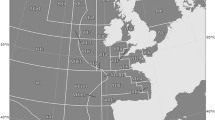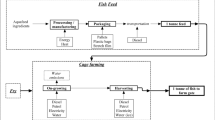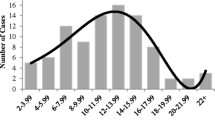Abstract
Purpose
The main purpose of this study has been to document the environmental performance of products based on autoline-caught cod and the distribution of environmental impacts in the value chain from fishing to retail. Another aim has been to document the performed environmental improvement analyses.
Methods
Standard life cycle assessment methodology has been employed and the following impact categories studied: global warming potential (GWP), acidification, eutrophication, photochemical oxidant formation, ozone layer depletion and cumulative energy demand.
Results and discussion
Products derived from autoline-caught cod have a GWP in the range of 0.16–7.6/1.7–4.4 kg CO2-eq/kg product delivered to consumer, using economic and mass allocation, respectively. The main impacts come from fuel consumption and release of refrigerants in the fishery. The products studied represent each of the four major processing outputs. The differences between the products can partly be attributed to differences in methodology (system borders, allocation), partly to actual physical differences. A comparison with published results from other studies indicates that seafood products sourced from Northeast Arctic cod fished with the autoline method has a relatively good environmental performance. A number of possible options for improving the environmental performance of the products were identified. The most internal improvement action was stopping leakages in fish freezers.
Conclusions
This study has given a detailed overview of the environmental performance of seafood products sourced from Northeast Arctic cod from autoline fisheries in Norwegian territorial waters. This study has demonstrated the usefulness of such results in improving the environmental performance of the products. However, the usefulness of the results in communication to external actors is limited because few data exists on other products fulfilling the same functions and using the exact same methodology and assumptions. In order to achieve comparability between results from competing products, it is necessary to use a standardised and detailed calculation method. At the moment, no such method seems to be available. The literature study indicated that the environmental impact of Northeast Arctic cod products sourced from autoline fisheries compares well with other cod products on the market. Some cod stocks are sustainably managed, others not. Hence, it is recommended to break down results not only to species level but also fish stock level when the aim is to guide seafood customers towards making informed purchasing decisions.







Similar content being viewed by others
References
Carlson K, Sonesson U (2000) Livscykelinventering av butiker. Data och metoder för at berekna butikens roll vid LCA av livsmedel (in Swedish). SIK Rapport 676, 2000
Ellingsen H, Aanondsen SA (2006) Environmental impacts of wild caught cod and farmed salmon—a comparison with chicken. Int J Life Cycle Assess 1(1):60–65
Ellingsen H, Lønseth M (2005) Energireduserende tiltak innen norsk fiskeri (in Norwegian). SINTEF Report.
Ellingsen H, Pedersen TA (2004) Designing for environmental efficiency in fishing vessels. Part B: Journal of Marine Design and Operation, no. B6, ISSN 1476–1556
Eyjólfsdóttir HR, Jónsdóttir H, Yngvadóttir E, Skúladóttir B (2003) Environmental effects of fish on the consumers dish- life cycle assessment of icelandic frozen cod products. Final Report May 2003. Icelandic Fisheries Laboratories and IceTec
FAO (2008) World review of fisheries and aquaculture. FAO, Rome
Gjøsæter H, Haug T, Hauge M, Karlsen Ø, Knutsen JA, Røttingen I, Skilbrei O, Sunnset BH (2010) Havforskningrapporten 2010 [In Norwegian]. Fisken og Havet. Særnummer 1–2010. Institute for Marine Research, Norway.
Guttormsdóttir AB (2009) Life cycle assessment on Icelandic cod product based on two different fishing methods. Master Thesis
Hospido A, Tyedmers P (2005) Life cycle environmental impacts of Spanish tuna fisheries. Fish Res 76:174–186
Huse I (2003) Fishing activity and ecosystem effects. Presentation delivered at 3rd workshop on LCA of Seafood. December 2003. IFL Project Report 28–03
ICES Cooperative Research Report. Spawning and life history information for North Atlantic cod stocks. Prepared by the ICES/GLOBEC Working Group on Cod and Climate Change. Rapport des Recherches Collectives No. 274. June 2005
Jonsdottir H (2008) Life cycle assessment of frozen cod products. Presentation at Nor-LCA Symposium. Fredrikstad, Norway, 21 May 2008
Magerholm Fet A, Schau EM, Haskins CA (2009) Framework for environmental analyses of fish food production systems based on systems engineering principles. Wiley, New York
Naylor RL, Burke M (2005) Aquaculture and ocean resources: raising tigers of the sea. Ann Rev Environ Res 30:185–218
Naylor RL, Goldburg RJ, Primavera JH, Kautsky N, Beveridge JC, Folke C (2000) Effect of aquaculture on world fish supplies. Nature 405:1017–1024
Schau EM, Ellingsen H, Endal A, Aanondsen SA (2009) Energy consumption in Norwegian Fisheries. J Cleaner Prod 17:325–334
Svanes E, Vold M, Hanssen OJ (2011) Effect of different allocation methods on LCA results of products from wild-caught fish and on the use of such results. Int J Life Cyc Assess (in press)
Tacon A (2005) State of information on salmon aquaculture feed and the environment. WWF. Feed Report for Salmon Aquaculture Dialogue
Thrane M (2003) Environmental impacts from Danish fish products. Ph.D. dissertation, Aalborg University (Denmark). Department of Development and Planning
Thrane M (2006) Environmental impacts from Danish fish products—new methods and insights. Int J Life Cycle Assess 11(1):66–74
Thrane M, Ziegler F, Sonesson U (2009) Eco-labelling of wild-caught seafood products. J Cleaner Prod 17:416–423
Winther U, Ziegler F, Skontorp Hognes E, Emanuelsson A, Sund V, Ellingsen H (2009) Carbon Footprint and energy use in Norwegian seafood products. SINTEF Fisheries and Aquaculture. December 2009
Ziegler F, Nilsson P, Mattsson B, Walther Y (2003) Life cycle assessment of frozen cod fillets including fishery-specific environmental impacts. Int J Life Cycle Assess 8(1):39–47
Author information
Authors and Affiliations
Corresponding author
Additional information
Responsible editor: Niels Jungbluth
Rights and permissions
About this article
Cite this article
Svanes, E., Vold, M. & Hanssen, O.J. Environmental assessment of cod (Gadus morhua) from autoline fisheries. Int J Life Cycle Assess 16, 611–624 (2011). https://doi.org/10.1007/s11367-011-0298-2
Received:
Accepted:
Published:
Issue Date:
DOI: https://doi.org/10.1007/s11367-011-0298-2




